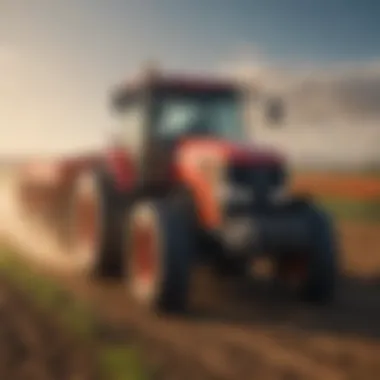Current Prices of New Tractors in Mexico: An Analysis


Intro
The agricultural sector in Mexico has witnessed significant changes in recent years, and understanding the current prices of new tractors is crucial for farmers and industry stakeholders. This comprehensive analysis aims to explore the various factors influencing tractor pricing, including brand reputation, model specifications, and regional economic conditions. It is essential for those involved in agriculture to recognize how these variables affect their purchasing decisions. Through informed insight, we can better navigate the complexities of the tractor market in Mexico.
Research and Data Analysis
Current Market Conditions
New tractors play an integral role in modern agriculture. Their performance can significantly impact crop productivity and efficiency. This section will analyze the current market dynamics and how they shape pricing.
Latest Trends in Agriculture and Horticulture
As technological advancements continue to seep into agricultural practices, the types of tractors used have evolved. New models often incorporate state-of-the-art features such as GPS guidance, precision farming technology, and eco-friendly engines. Buyers must keep up with these trends, as they directly affect the cost and operational efficiency.
Statistical Insights into Crop Yields
Recent statistical data indicates a correlation between the type of equipment used and crop yields. For instance, farms that invest in high-quality tractors report higher yields due to improved efficiency in soil preparation and planting. Understanding this relationship can guide purchasing decisions towards models that enhance productivity.
"Investing in quality equipment is not just about immediate cost, but about long-term benefits to crop yields and operational efficiency."
Pricing Breakdown by Brand and Model
Different brands, such as John Deere, Massey Ferguson, and Kubota, offer various models that cater to specific agricultural needs. Below is a brief overview of some popular models:
- John Deere 5055E: A versatile tractor well suited for small to medium-sized farms, priced around $25,000.
- Massey Ferguson 5700 Series: Known for its fuel efficiency and reliability, with prices starting from $30,000.
- Kubota L2501: Ideal for diverse farming activities, its price is approximately $23,000.
Regional variances also play a role in pricing, as dealerships in different states may adjust their prices based on local demand and logistical costs.
Economic Factors and Government Policies
Government policies regarding agriculture also significantly influence the tractor pricing landscape. Subsidies for farmers purchasing new equipment can lower initial costs. Beside this, fluctuations in currency exchange rates may affect the prices of imported tractors, making it crucial for buyers to stay informed about both local and international economic conditions.
Ending
Understanding the price dynamics of tractors in Mexico necessitates a multifaceted approach. With knowledge of market trends, brand comparisons, and economic factors, farmers can make well-rounded decisions that align with their operational goals. As the agricultural sector continues to evolve, staying informed about equipment choices remains imperative for success.
Prelude to Tractor Pricing in Mexico
Understanding the pricing of tractors in Mexico is crucial for anyone involved in agriculture. Tractors represent significant investments for farmers, influencers in enhancing productivity and efficiency. Knowing their costs can help farmers make educated purchases, ensuring they get fair value. In the Mexican agricultural landscape, where economies vary widely, a comprehensive understanding of tractor pricing helps farmers tailor their machinery choices according to their specific needs.
The significance of this topic extends beyond simple numbers. It reveals the dynamics of the agricultural market, and how external factors play a role in shaping pricing trends. Moreover, being informed about tractor pricing assists farmers in budget planning and investment strategy. It is not only about acquiring machinery; it is also about making a strategic choice that will yield returns in a long-term perspective.
Tractor prices in Mexico fluctuate due to various contributing elements, making it vital to grasp these intricacies. It is important for stakeholders to keep abreast of these factors, as they directly affect operational costs and project feasibility. This section sets the groundwork for a deeper exploration into the tractor market, guiding readers through the nuances that define current pricing.
Defining Tractor Categories
Tractors come in different categories based on size, power, purpose, and technology. Common categories include:


- Compact Tractors: Suited for small farms or residential use.
- Utility Tractors: Versatile for various tasks, including hauling and plowing.
- Row Crop Tractors: Designed primarily for crop production and increasing efficiency in field operations.
- Specialty Tractors: Customized for specific agricultural tasks like vineyard care or orchard management.
Understanding these categories is essential, as prices vary significantly between them. Compact tractors tend to be less expensive than row crop tractors, which require more power and advanced features.
Significance of Tractors in Agriculture
Tractors are pivotal in modern agriculture. They facilitate various tasks, including tilling, planting, and harvesting. This machinery not only boosts productivity but also enhances precision farming techniques that are indispensable in today’s competitive market.
The importance of tractors is seen in:
- Efficiency Improvement: They reduce the time and labor required for farm tasks.
- Crop Yield Maximization: With the right equipment, farmers can produce better quality crops.
- Cost Savings: While the initial investment may seem high, effective tractor use can lead to savings in the long run.
Given their role, understanding tractor pricing is not only relevant for purchasing decisions but also for determining how to leverage equipment for maximum benefit in agricultural practices. Overall, the interplay between tractor pricing and agricultural success cannot be overstated.
Understanding the Market Dynamics
Understanding the market dynamics of tractor pricing in Mexico is crucial. This section articulates the interplay between various forces that shape the pricing landscape. The tractor market does not operate in isolation but rather is influenced by economic, technological, and regulatory factors. Recognizing these elements can help buyers make informed decisions and anticipate future trends.
Factors Influencing Tractor Prices
Supply and Demand Trends
Supply and demand are foundational economic principles affecting tractor prices. In Mexico, the agricultural sector's growth influences how many tractors are available versus how many farmers need them. When demand rises, perhaps due to an uptick in agricultural production or an increase in crop prices, tractor prices tend to rise as well. Conversely, if supply exceeds demand, as can happen during market saturation, prices may decline.
One key characteristic of supply and demand trends is their inherent volatility. They shift based on various events such as droughts, changes in crop production, or economic shifts. This aspect is essential for understanding how tractors are priced. The unique feature of this dynamic is its responsiveness to real-time market conditions, providing both advantages and disadvantages. High demand can lead to higher costs, whereas oversupply can create bargains.
Currency Fluctuations
Currency fluctuations directly impact tractor pricing. Given that many parts or even whole tractors may be imported, the value of the Mexican peso against other currencies becomes significant. When the peso weakens, the cost of imported tractors can rise. This directly affects local pricing, often making new tractors more expensive for Mexican farmers.
A notable characteristic of currency fluctuations is their unpredictability. Changes can happen rapidly due to market conditions or government policy shifts. This unpredictability makes it difficult for farmers to plan financially. The unique feature is that these fluctuations highlight the importance of hedging strategies for agricultural businesses that rely on imported equipment. This can shield buyers from sudden price shifts but may require additional management and financial expertise.
Technological Advancements
Technological advancements in tractor manufacturing present another layer influencing prices. New models with enhanced features such as advanced GPS systems, automated controls, and fuel-efficient engines often come at higher price points. These technologies increase productivity and efficiency, making them appealing to buyers.
The critical aspect of technological advancements is their ongoing evolution. Manufacturers continuously innovate to meet the demands of modern agriculture. This constant improvement raises the cost but also offers greater benefits in terms of farm productivity. The unique feature here is the balance of investment against potential returns. While initial costs may deter some farmers, the long-term efficiency gains often justify the investment.
Impact of Government Regulations
Import Tariffs
Import tariffs are another essential factor affecting tractor pricing in Mexico. These tariffs are taxes imposed on imported goods, including tractors. When tariffs increase, the cost burden typically shifts to the consumer, resulting in higher prices for farmers. Furthermore, tariffs can deter imports, which may lead to supply shortages in the market. This aspect emphasizes how government policy can instantly affect market prices and availability.
The key characteristic of import tariffs is their role in trade balance. They can protect local manufacturers but may limit choices for consumers. The unique feature of tariffs is that they introduce complexity in cost structure, meaning that understanding them is vital for buyers to navigate pricing effectively. Opportunities may exist for farmers to advocate for lower tariffs, which could benefit the overall market.
Incentives for Farmers
Incentives for farmers, such as subsidies or loan programs, can significantly impact tractor pricing. These incentives can make it easier for farmers to afford new equipment or offer rebates for purchasing more sustainable models. By reducing the effective cost, these initiatives encourage tractor purchases, stimulating the agricultural economy.


The essential aspect of farmer incentives is their intention to promote agricultural productivity. These financial supports aim to support local farmers and enhance food security. The unique feature of incentives is their potential to democratize access to advanced farming equipment, benefiting not only larger commercial farms but also smallholder farmers. However, these programs require careful examination to ensure that they effectively reach intended recipients and do not inadvertently skew market dynamics.
"Understanding the intricate factors shaping tractor prices is vital for making informed agricultural investments."
In summary, grasping the market dynamics surrounding tractor pricing allows farmers and stakeholders to navigate challenges and opportunities within the agricultural sector. From understanding the essentials of supply and demand to considering the impact of regulatory measures, each aspect plays a crucial role in future purchasing decisions.
Comparative Analysis of Popular Tractor Brands
In the Mexican tractor market, understanding brand dynamics is essential for farmers and agricultural professionals. Each brand has unique pricing strategies, features, and market positioning, which affect purchasing decisions. This section provides a comparative analysis of popular tractor brands, focusing on price trends, product offerings, and market relevance.
John Deere Pricing Overview
John Deere is a prominent player in the tractor market both in Mexico and globally. Known for its reliability and advanced technology, John Deere tractors often come at a higher price point compared to competitors. The company’s pricing strategy reflects the quality and performance of its products.
Prices for John Deere tractors can vary widely depending on the model and features included. Generally, entry-level models start around $15,000 while advanced models, with high-end features, can exceed $100,000.
Features like precision agriculture technology add to the costs but offer significant advantages in efficiency and productivity for farmers. Farmers should weigh these benefits against their budget constraints.
Case IH Pricing Strategies
Case IH adopts a different approach in its pricing strategies. The brand targets a diverse audience, providing a range of tractors from utility to high-horsepower models. This allows flexibility for buyers with different needs and financial capabilities.
The price of Case IH tractors typically starts at approximately $20,000 for basic models, scaling up to $150,000 for more advanced versions. Their models often include integrated technology packages that appeal to tech-savvy farmers looking for IoT solutions in their agricultural practices.
The brand’s commitment to innovation, particularly in fuel efficiency, is a significant consideration for many buyers looking to reduce operational costs over time.
New Holland Positioning
New Holland focuses on positioning itself as a cost-effective solution in the tractor market. The brand provides a solid line of tractors with competitive pricing, making them appealing for small to medium-sized farms. Prices generally run from about $18,000 for basic models, reaching up to $120,000 for high-performance units.
New Holland emphasizes service and support, ensuring that customers receive adequate assistance post-purchase. Many farmers find this support critical, especially when investing in new machinery.
Massey Ferguson Trends
Massey Ferguson is historically known for delivering value and performance. They maintain a balanced pricing strategy aimed at both emerging and established markets. The starting price for Massey Ferguson tractors is around $16,000, with premium models reaching up to $130,000.
The brand is recognized for its adaptability and focus on the needs of farmers in diverse agricultural settings. Their recent trend towards sustainability and energy-efficient solutions positions Massey Ferguson as relevant in a market increasingly prioritizing eco-friendly practices.
"When choosing a tractor, understanding the brand's vision and market strategy can significantly impact your purchasing decision."
In summary, a comparative analysis of these brands reveals distinct pricing structures, which reflect their product offerings and target markets. Farmers should consider their specific needs and budget when evaluating options in the Mexican tractor market.
Regional Price Variations Across Mexico
Price Disparities in Northern Mexico
In Northern Mexico, the price of new tractors tends to be higher compared to other regions. This can be attributed to several factors. First, the region has a robust agricultural sector focused on large-scale farming. This leads to an increased demand for high-capacity tractors, which influences overall market prices. Additionally, Northern states like Chihuahua and Sonora have better access to agricultural technology, elevating the quality and subsequently, the price of the machinery.


Economic conditions also play a role in these disparities. In areas with strong economic growth, prices may reflect higher levels of investment in agricultural equipment. Also, logistics and transportation costs can be significant in this region, affecting the final price of tractors. Availability of financing options and dealership networks can also vary, further influencing the prices.
Comparing Central and Southern Mexico
When comparing Central and Southern Mexico, the pricing landscape displays noticeable differences. In Central Mexico, states such as Jalisco and Guanajuato generally feature competitive pricing due to a larger number of dealerships and a more varied selection of tractor brands. It tends to be easier for farmers in this region to compare prices and negotiate better deals.
Contrarily, Southern Mexico experiences challenges that often lead to higher prices. Regions like Chiapas and Guerrero may struggle with limited access to dealerships. This results in fewer options for farmers and can cause prices to remain inflated. In addition, economic activities in these southern states can be less robust, affecting the purchasing power of local farmers.
In both regions, farmers should closely observe these price variations and understand the underlying factors that contribute to them. By doing so, they can better strategize their investments and improve the effectiveness of their operations.
"Regional pricing variations in tractors are not just numbers; they represent the agricultural viability and investment potential of each area."
By acknowledging these regional distinctions, farmers can align their purchasing power with market opportunities, optimizing their farm management strategies effectively.
Future Trends in Tractor Pricing
Understanding future trends in tractor pricing is critical for stakeholders in the agricultural sector. As the global economy evolves, several factors will influence the costs associated with acquiring new tractors in Mexico. Insights into these trends can help farmers, suppliers, and dealers make strategic financial decisions that reflect both current and anticipated market conditions. Recognizing these shifts will enable relevant parties to plan adequately, whether it involves investing in new technology or adjusting to fluctuations in demand.
Emerging Technologies in Tractor Manufacturing
Recent developments in technology are reshaping the tractor manufacturing industry. Automation and precision farming technologies are increasingly integrated into new models. These innovations improve efficiency and productivity, aiming to reduce labor costs and enhance yields for farmers. Examples include tractors equipped with GPS technology that enable farmers to optimize their planting and harvesting processes. Furthermore, advancements in data analytics allow real-time monitoring of equipment performance, leading to better maintenance and longevity for these machines.
The implementation of electric and hybrid tractors is another crucial advancement. As environmental concerns rise, manufacturers are focusing on reducing carbon footprints. Electric tractors are being tested and adopted in various markets. They provide a more sustainable option by curbing reliance on fossil fuels. This shift may initially impact pricing, as the cost of production for electric models may be higher due to advanced technology. However, long-term savings related to fuel and maintenance could offset the initial investment costs, making electric tractors increasingly attractive.
Sustainability and Tractor Evolution
Sustainability is a growing concern in agriculture, and its implications extend to tractor pricing. A shift towards sustainable farming practices compels manufacturers to innovate and modify their production processes. This trend means that future tractor models will likely incorporate eco-friendly materials and designs. Farmers may need to adopt more sustainable practices, and this push for sustainability will influence pricing strategies.
In addition to environmental considerations, consumer demand is changing. Today's buyers are more environmentally conscious and lean towards brands that demonstrate a commitment to sustainability. Thus, manufacturers who prioritize these values may experience a competitive edge, impacting their pricing approaches.
Moreover, as the agricultural landscape continues to change due to climate fluctuations, tractors will need to adapt to new methodologies for soil cultivation and crop production. The evolution of tractors must accommodate these changing agricultural practices. As such adaptations may require research and development investment, the pricing of these tractors could reflect the costs involved in fostering innovation.
"The future pricing of tractors is closely linked to technological advancements and sustainability practices. Both provide opportunities and challenges for manufacturers and farmers alike."
In summary, understanding the future trends in tractor pricing involves recognizing the technological innovations driving changes in manufacturing and the need for sustainability. These elements not only shape the market but also influence purchasing decisions and strategies moving forward.
The End and Recommendations
Strategic Purchasing Decisions
When approaching the purchase of a new tractor, several factors should be considered to ensure a strategic decision. First, it is essential to evaluate your specific farm needs. This includes understanding the size of your operations, the types of crops grown, and the terrain where you will operate your tractor. Additionally, it is pertinent to look at tractor specifications including horsepower, fuel efficiency, and maintenance requirements.
Key Elements to Consider:
- Cost vs. Value: Ensure that the price aligns with the features and expected performance of the tractor.
- Resale Value: Some brands retain a higher resale value due to reliability and brand reputation.
- Warranty and Support: Choose manufacturers that offer substantial warranties and customer service.
- Financing Options: Understanding financing plans can ease the financial burden of purchasing a high-cost item like a tractor.
These decisions can lead not only to immediate satisfaction but also long-term success in agricultural productivity.
Importance of Market Research
Conducting thorough market research is crucial for anyone looking to purchase a tractor. The market is influenced by numerous changing factors such as new technologies, agricultural policies, and trends in consumer preferences. Farmers should stay updated on these trends to optimize their purchasing strategies.
Benefits of Market Research:
- Informed Pricing Decisions: Knowledge of average prices and current sales can help negotiate better deals.
- Understanding Market Trends: Identifying when to buy a tractor or which models are in demand can significantly impact purchasing costs.
- Identifying Best Brands: Research helps to ascertain which brands provide reliable products and efficiency in after-sales service.















